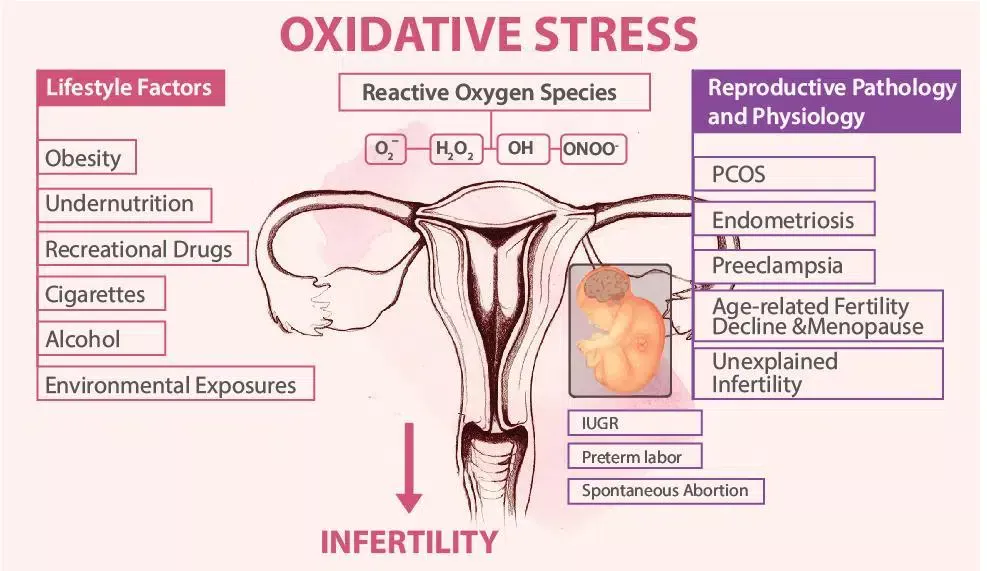The effects of oxidative stress on female reproduction

According to the World Health Organisation, infertility is a primary global health concern that affects millions of men and women of reproductive age. Close to 48 million couples and 186 million individuals experience infertility on a global scale. Lifestyle choices, exposure to environmental pollutants, obesity, malnutrition, recreational use of drugs, smoking and alcohol consumption are known to contribute to fertility complications or reproductive diseases among women and men alike.
In recent years, research suggests that oxidative stress or OS (a disturbance in the biological equilibrium at the intracellular level) may significantly impact female reproduction. Most lifestyle factors mentioned earlier are found to trigger oxidative disturbances directly. Furthermore, OS is known to affect both natural and assisted reproductive techniques. Therefore, the study of OS has become significant, especially in relation to female subfertility.
Through this article, HHC gives you a complete understanding of what oxidative stress is and its effects on female reproduction. We provide a wide range of OXIDATIVE STRESS assay kits to enable reliable and accurate diagnosis in the field of reproduction.
What is Oxidative Stress?
Briefly, oxidative stress results from an imbalance between pro-oxidants (Reactive Oxygen species or ROS and Reactive Nitrogen species NOS) and antioxidants that defend and neutralise ROS.
Let’s understand this in detail now.
Every living organism has a constant and continuous formation of ROS (also called free radicals) due to internal or biochemical reactions and external or environmental factors. To maintain proper cell function, ROS, which are pro-oxidant molecules created by aerobic respiration and metabolism, mainly by mitochondria, must be continuously inhibited by antioxidants to prevent excess production. OS arises when the formation of ROS and other radical species surpasses their ability to be scavenged by antioxidants due to excessive ROS production, insufficient antioxidant intake, or increasing antioxidant usage.
Disturbances in the normal redox state of the cells can create toxic effects through the production of peroxides and free radicals. These harmful effects damage the cell components, including DNA, proteins and lipids, and severe oxidative stress causes cell death and necrosis.
In lay terms, ROS comprise waste products that cells create as they digest food and respond to their environment. ROS are volatile and reactive bodies. To become stable, they react with electrons from nucleic acids, lipids, carbohydrates, proteins, or molecules in proximity, all of which bring about a string of chain reactions causing cellular damage and, thus, disease. Antioxidants protect against cell damage caused by ROS, also known as oxidative stress. OS may affect physiological processes.
Primarily, ROS consist of hydroxyl radicals (OH), superoxide anion (O2−), hydrogen peroxide (H2O2), nitric oxide (NO), peroxyl (ROO•), alkoxyl (RO•) and hydroperoxyl (HO 2•).
Antioxidants can originate naturally or artificially. The body produces endogenous antioxidants. Exogenous antioxidants originate from outside the body. The body typically contains two different forms of antioxidants: enzymatic antioxidants and non-enzymatic antioxidants. Superoxide dismutase (SOD), glutathione peroxidase (GPx), catalase (CAT), and glutathione reductase (GSR) are examples of enzyme antioxidants. Vitamin C, E, alpha-carotene, selenium, zinc, taurine, glutathione, and other nutrients are non-enzymatic antioxidants.
How do ROS affect female reproduction?
Antioxidants and ROS collaborate to control reproductive functions in both humans and animals. ROS, when produced in excess, without adequate counteraction from antioxidants, oxidative stress occurs. ROS target various biological elements in proximity due to their highly reactive nature and may also influence the sperm, oocyte and embryos in their tubal fluid, follicular fluid, and peritoneal fluid microenvironments, altering reproductive outcomes.
It is important to note that while ROS in overabundance are harmful, they also play a vital role in the female reproductive process. They have a crucial influence on pathological processes involving the female genital tract and serve as secondary messengers in numerous intracellular signaling cascades. ROS may play a significant role as mediators for ovulation, oocyte maturation, folliculogenesis, ovarian steroidogenesis, luteolysis, luteal maintenance during pregnancy, implantation, compaction, blastocyst development, germ cell activity, and corpus luteum formation.
What are the effects of Oxidative Stress on female reproduction?
Several conditions affecting female reproduction could be caused by OS, such as endometriosis, preeclampsia, polycystic ovary syndrome (PCOS) and unexplained infertility. In response to OS, pregnancy problems such as hypertension, spontaneous abortion, and recurrent pregnancy loss might also manifest.
Oocytes and spermatozoa may experience direct damage in ovarian follicles, resulting from an environment of OS in the peritoneal cavity. In some cases, even during fertilisation, OS can incite apoptosis promoting embryo fragmentation, implantation failure, abortion, or congenital abnormalities in offspring.
Oxidative disturbance in the fallopian tubes can impact the embryo. ROS-antioxidant imbalance in the female reproductive tract can alter and damage the endometrium, which promotes embryo development. OS is also implicated in defecting a pregnancy in progress, causing insufficient luteal hormonal support and luteal regression.
Finally, oxidative stress can cause disruptions in normal mechanisms of cellular signaling. Besides affecting female reproduction, oxidative stress is also believed to promote the development of several diseases, including Asperger syndrome, ADHD, cancer, Parkinson’s disease, Alzheimer’s disease, atherosclerosis, heart failure, myocardial infarction, fragile X syndrome, lichen planus, Sickle Cell Disease, infection, vitiligo, chronic fatigue syndrome, depression and autism.
There is no other biological system as complex and intricate as female reproduction. While OS is undoubtedly a concern when discussing infertility and reproductive disease, studies have reported mixed results regarding detecting OS markers for all reproductive disorders. Antioxidant supplementation may potentially overcome problems related to infertility.
However, so far, tests have been conducted only using in vitro or animal experiments, frequently leading to inconsistent outcomes. Future randomised controlled clinical trials on people are required to determine the exact way in which OS impacts fertility capacity and will enable additional research into the potential advantages of antioxidants as a treatment for infertility.
Helvetica Health Care provides efficient testing and diagnostics products to improve lab efficiencies in the detection of OS biomarkers to assess female reproductive disorders. Our range of OXIDATIVE STRESS assay kits and standards is designed to assist in the exploration of oxidative stress markers and metabolites in human and animal samples and samples exposed to drugs and foods.
The TBARS (Thiobarbituric Acid Reactive Substances) assay has become the assay of choice for screening and monitoring lipid peroxidation, a primary indicator of oxidative stress. The assay can be used with many types of samples, including drugs, food products and material of human and animal origin, and provides standardised and reproducible results.
Need more information on what we do and how we improve health and life?
